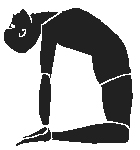Introduction

The indigestion may be related to abnormal motilitythe squeezing or relaxing actionof the stomach muscle as it receives, digests, and moves food into the small intestine. The main cause of indigestion is stomach acid reflux. Stomach acid helps to digest food and protects human body from infections. Stomach, esophagus and intestine are lined with a mucus layer and this layer acts as a barrier against the stomach acid. The acid irritates tissues underneath when this mucus layer is damaged. For this reason the sphincter connecting the esophagus and stomach does not work properly causing stomach acid reflux. Making some changes in lifestyle is essential to improve digestion system. The most effective changes would be to change food habits. Salads and steamed vegetables should be taken instead of fried and spicy food. Taking alcohol, coffee and tea must be limited.
Yoga and Indigestion
Yoga works in a systematic manner to clear the blockages so your digestive system functions properly and you no longer suffer from indigestion. Certain yoga asana that are inverted are extremely beneficial for treating indigestion since they force your blood to flow in the opposite direction. This helps to take the strain off from your lower body and when you return to your normal position the blood rushes back, this helps to clear any blockages and also nourishes your system with a fresh supply of fresh blood and oxygen so your system rejuvenates itself and functions at its optimum level. To avoid indigestion besides practicing yoga you need to take care of some general things such as eating more small meals instead of few large meals, chew your food well, avoid consuming fatty, spicy, food, alcohol, tea and coffee, get proper rest and avoid being stressed and worried. Yoga can be used to stimulate digestion and movement along the digestive tract. Specific yoga positions help to stretch, twist and squeeze the torso, improving digestion, as well as the circulation and function of the organs within this region of the body.YOGA POSES FOR INDIGESTION
Extended Angle Pose
Parshva means side or flank. Kona stands for angle. Thus this is the extended lateral extended angle pose. Stand in Tadasana. Inhale deeply and with a jump, spread the legs apart sideways 4 to 4.5 feet. Raise arms sideways in line with the shoulder, palms facing down.Seated Twist Pose
This seated twist stimulates and massages the internal organs of the abdomen, improving digestion and the function of the liver and kidneys.Seated Forward Bend Pose
This seated bend stimulates the internal organs and is also beneficial in relieving some symptoms of menopause and PMS.Legs up the Wall Pose
This calming pose relieves mild back pain and revives aching legs and feet.Warrior Pose One
The Warrior Pose I or Virabhadrasana I improves balance and agility and strengthens your legs, back, and arms. It also targets the chest, shoulders, neck, and abdominal area.Warrior Pose Two
This posture strengthens your legs, back, shoulders, and arms, building stamina. It opens your hips and chest, and improves balance. It is called the Warrior in reference to the fierce warrior, an incarnation of Shiva.Child's Pose
The Child Pose is a relaxation pose which is used to normalize the circulation after the Head Stand and to give a counter stretch to the spine after the backward bends. It is a resting pose that can be done to precede or follow any pose. Performing the Child Pose stretches the hips, thighs and ankles gently. It also helps relieve stress and fatigue, and calms the brain.Plough Pose
A lot people complain about stiffness on the neck and lower back as a result of stress and wrong posture. In the Plough Pose, you stretch the neck and the lower back muscles. The Plough is also good for your digestion and it strengthens the kidneys, the liver and the gall bladder.Wind Relieving Pose
In the Wind Relieving Yoga Pose, the excess gas would be removed from the stomach and intestines, thus improving the digestive system. This Yoga Pose will also tone and stretch your lower back.YOGA ASANAS FOR CERVICAL SPONDYLOLYSIS
UTTHITAPADMASANA

Steps
- Place both palms on the floor beside the thighs. While inhaling, lift up your body and balance its weight on the palms. Look straight.
- Try to keep your spine and elbows straight. Hold this for some time.
- Then, while exhaling, slowly return to the normal position. Repeat by changing the position of the legs.
KATICHALANA

Steps
- Lie flat on your back, bend your legs at the knees and bring your feet near the hips. Interlock the fingers of both your hands and keep them under the head.
- Now exhale and put a little pressure on the waist. Twist your knees to the right, simultaneously turning your head and neck to the left. Maintain normal breathing.
- Again, while exhaling, twist the knees to the left turning the head and neck to the right. Repeat this three to four times on each side. Return to the normal position and then relax. Like Katichalana (cross leg-twisting pose) lie in Shavasana, bring legs together and hands together.
- Fold both your legs and cross right over the left. Inter-locks finger of both your hands and keep them under your head. Look towards the left and vice versa. Change the leg, left over the right. While exhaling, twist the leg right and look at left and vice versa. Maintain the final position for a minute, breathe normally and return in reverse order.
USTRASANA

Steps
- Sit in Vajrasana i.e. squat on the floor, toes pointing backwards.
- Now, stand on your knees with arms at the sides.
- Spread knees about half a foot apart.
- Bend your body backwards and hold your ankles with both hands so that you end up looking at the ceiling.
- Push the abdomen forward as much as possible keeping the thighs vertical.
- Return to the starting position, slowly releasing the hands from the ankles, one at a time.
- Return to Vajrasana and relax breathing normally.
- As with all yoga, make sure to monitor and steady your breathing.
- Avoid this pose if you have any serious injury to your lower back or neck.
MAKARASANA

Steps
- Start lying on belly, feet turned out.
- Bend your elbows, holding onto opposite elbows and placing your elbows on the floor forward from your shoulders.
- Drop your forehead to your forearms. Your chest should be off the floor and your head should comfortably reach your forearms, while your neck and shoulders remain comfortable. Make any adjustments to the position of your arms that you need to make.
- Begin breathing deeply into your belly, breathing through your nose. Your belly should press against the floor as you inhale and relax as you exhale. This provides a gentle massage to your internal organs, helps strengthen your diaphragm and helps to stimulate circulation throughout your torso.
- Stay in this position for 8-10 long, slow belly breaths.
- Release your elbows and press back to child's pose or come up to sitting.
MANDUKASANA

Steps
- Sit in Vajrasana with both the legs bent in the rear.
- Keep both the paws of the legs touching each other. Keep both the heels opened out. Sit with waist and back straight supporting the buttocks on the two heels.
- Now separate the knees as far apart as possible. This is Manduk sitting.
- Now for Mandukasana bring both the knees in the front touching each other.
- Close both the fists of the hands and keep them on the belly on both the sides of the navel.
- Lower the body in front and let the forehead touch the ground.
Diseases Related to Cancer |
||


